The NVIDIA SHIELD Android TV Review: A Premium 4K Set Top Box
by Ganesh T S on May 28, 2015 3:00 PM EST- Posted in
- Media Streamer
- Home Theater
- TV
- 4K
- Shield
- NVIDIA
System Performance
From an editorial perspective, the SHIELD Android TV may be one of the most frustrating devices we’ve worked on in recent history. Simply put, the Android TV market is still a tiny market. Google’s Nexus Player is most of the market right now, and only very recently have other Android TV devices such as the Forge TV and SHIELD Android TV reached the market.
As a result, figuring out what to compare the SHIELD Android TV to and how to present it has been an interesting challenge. A set top box is not a mobile device, and while they share similar OSes and the same families of SoCs, that does not make them identical devices. At the same time however, if we restrict ourselves to just Android TV devices, it would be a very limited and uninteresting comparison. The Nexus Player is a quad-core Intel Atom, but only includes 1GB of RAM, among other limitations.
Ultimately it’s clear that the SHIELD Android TV is heavily overspeced compared to other Android TV devices – no one else is pursuing this premium market – so instead we’re going to focus on looking at benchmarked performance relative to the newest generation of SoCs in the latest iOS and Android tablets. This is by no means a fair matchup and we need to be clear about this – the SHIELD Android TV has no throttling or power constraints, no need to balance out energy efficiency – but it at least gives us some idea of how the device and Tegra X1 compare to other products. Just don’t expect to see a Tegra X1 tablet perform this well. And in the meantime, some of the results may surprise you.
As always for an Android device review, we'll start off with our browser benchmarks. SHIELD Android TV doesn’t actually ship with a browser – we had to sideload Chrome – but these are among our most flexible benchmarks and help put performance in context of more than just Android devices.
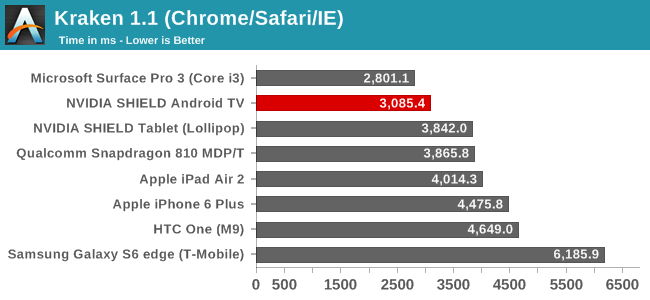
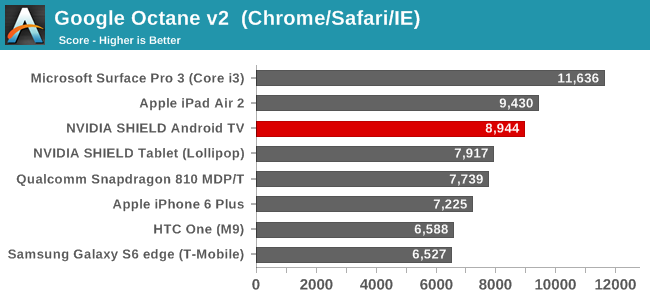
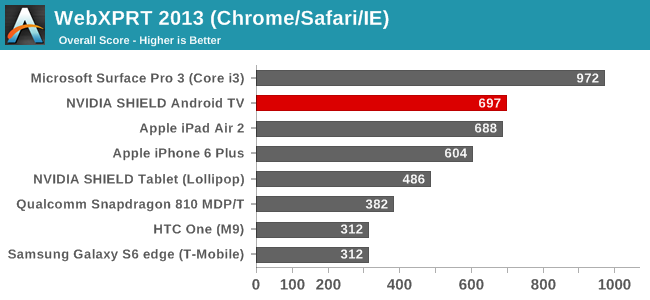
Among Android devices, the SHIELD Android TV stands alone, as you’d expect. Without any throttling to hold it back, it leads over Tegra K1, Snapdragon S810, and Exynos 7420 over all 3 web benchmarks. That said, even with its unrestricted Cortex-A57 CPU cores, we also find that Apple’s A8X-based iPad Air 2 is a close match in Octane and WebXPRT, just edging out the SHIELD Android TV and being edged out respectively. Meanwhile for anyone curious how this compares to high-end x86 tablets like the Surface Pro 3, well even SHIELD Android TV isn’t quite up to par with those devices at this time.
Moving on, we have Basemark OS II 2.0, which should give a better picture of CPU performance in addition to overall device performance.
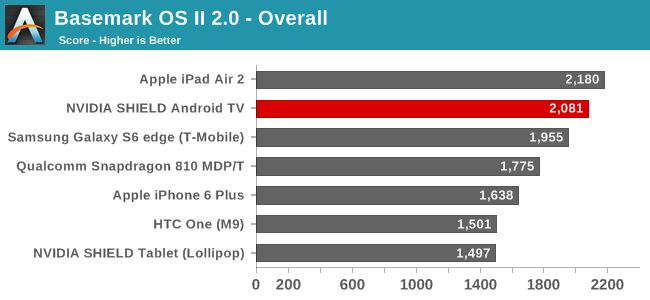

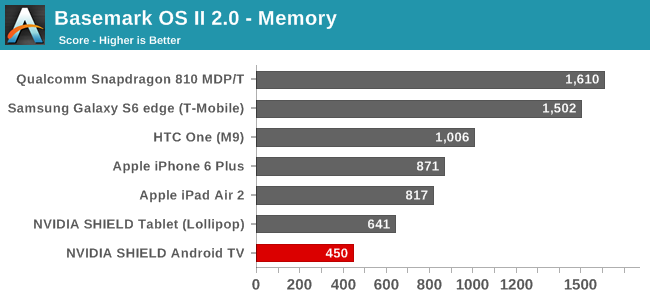
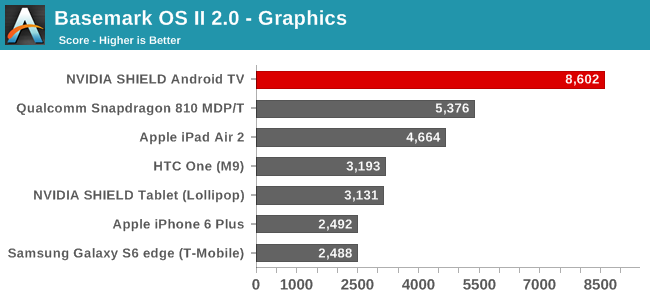
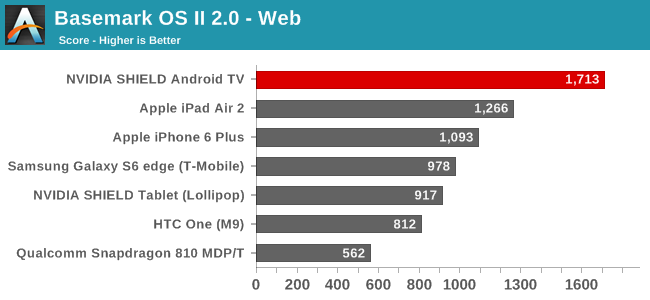
Overall, performance under Basemark still slightly favors the iPad Air 2. SHIELD Android TV easily takes the second spot, but it’s not enough to catch Apple’s tablet.
Looking at the subscores, we can see why this is. SHIELD Android TV only fares decently under the System test, but not well. The big surprise here is not the iPad, which always does well, but the fact that the SHIELD is so far behind the Galaxy S6, which features a similar CPU setup. As this sub-test pushes both the CPU and memory, we may be seeing something related to the implementation differences between Tegra X1 and Exynos 7420, or it may just be an Android TV-inspired difference.
However the memory score is particularly bad, coming in behind even the last-generation SHIELD Tablet. As this is a NAND test, what we're likely seeing is a consequence of the SHIELD's poor random performance, something we'll dive into a bit later in our detailed look at NAND performance.
On the other hand, graphics and web performance are outstanding. We had certainly expected the SHIELD to do well in graphics given what Maxwell is capable of – it is a graphics monster unlike any other current SoC – but the web test is a pleasant surprise. The combination of using Android TV’s built-in web view and the lack of any real throttling likely play a big part here, and although Android TV doesn’t ship with a standard web browser, this bodes well for any apps making use of web view and Javascript.
Our next system benchmark is PCMark, which does a number of basic benchmarks designed to stress various aspects of the device in everyday workloads like video playback, web browsing, text editing, and photo editing. This tends to test every aspect of a mobile device, unlike microbenchmarks that can often miss aspects of the system that can affect performance.
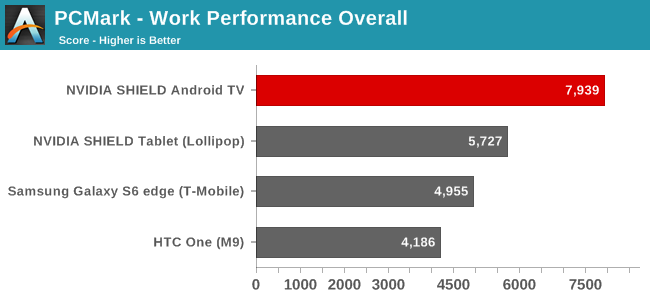
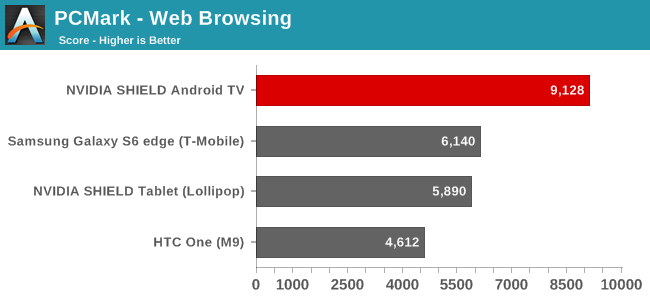

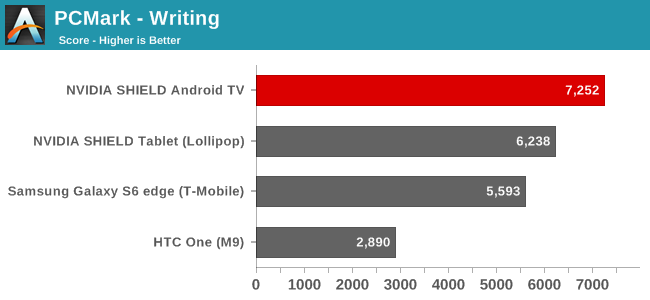
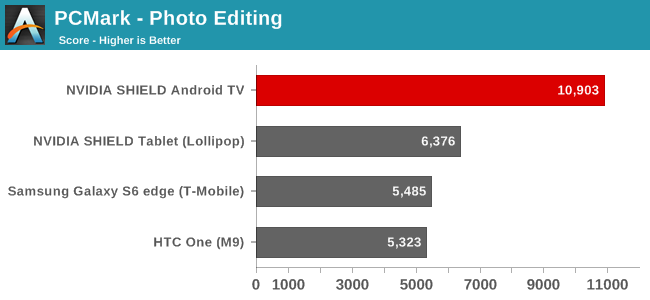
With the exception of the Writing subtest, where the SHIELD Android TV and second-place device are kind of close, PCMark is a runaway victory for the SHIELD Android TV. Once again we’re almost certainly seeing the benefits of the box’s aggressive performance since it doesn’t need to throttle down, or even be conservative on clockspeeds for power purposes. In which case it gives us an interesting look at what Cortex-A57 can do when not held back.
Overall, CPU/system performance is more or less what one would expect based on the design of the SHIELD. As a set top box with a quad-core A57 implementation under the hood and the cooling to let it run wild, SHEILD is frequently A57 at its best. Which means it’s going to easily surpass other A57 devices in most situations, but it also means that even with its unrestricted performance, Apple’s A8X processor and its tri-core “Enhanced Cyclone” CPUs still serve as a reminder of those times where A57 struggles against Enhanced Cyclone’s high-IPC design.
For our final look at system performance, let’s take a quick look at the SHIELD's built-in NAND performance with AndroBench 4.0.
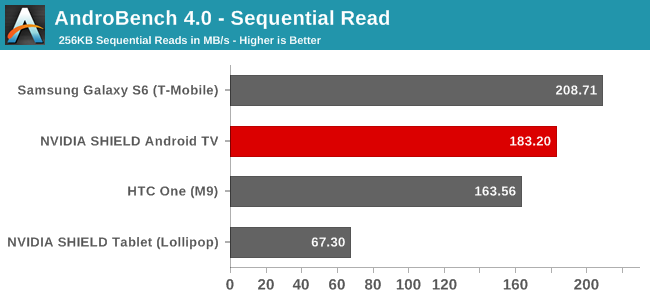
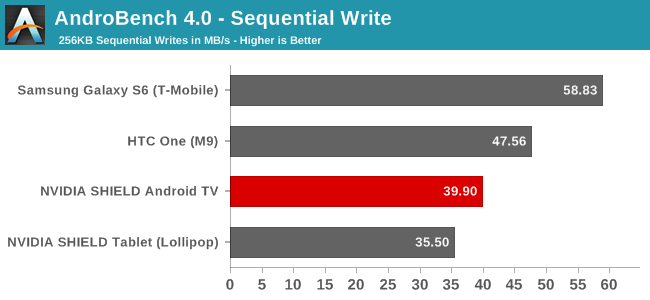
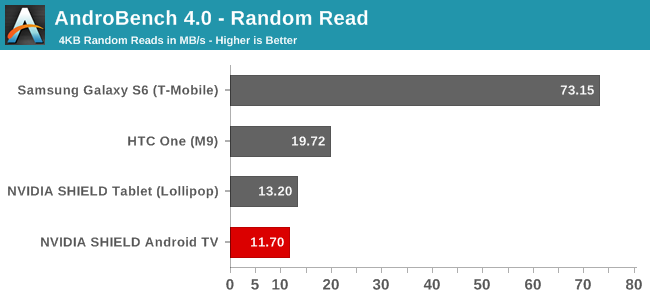
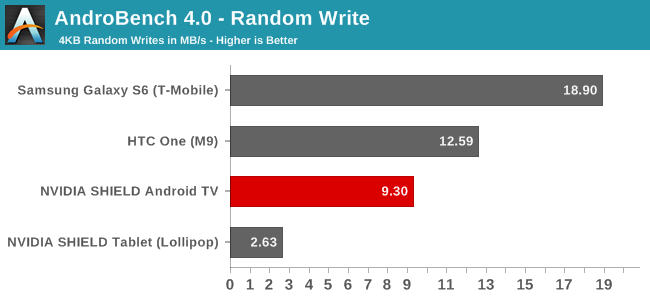
Update 5/28: AndroBench numbers have been revised to account for an error, sorry about that
Though we only have a few AndroBench 4.0 results compiled so far, it’s enough to paint a decent picture. For sequential reads the SHIELD’s built-in NAND fares relatively well. It’s not enough to top the Galaxy S6 and its UFS flash, but it’s keeping up with the pack. Sequential writes on the other hand aren't quite as good, with write performance ahead of only the SHIELD Tablet. Meanwhile random performance is a real mixed bag; the SHIELD Android TV is at the bottom of the random read chart - below even the SHIELD Tablet - while random write performnace is significantly better than the tablet, but still chasing the M9 and well off the S6.
Among Android flagship devices UFS definitely gives the Galaxy a big benefit here, but the SHIELD could stand to improve all the same. However I’m not sure how much that matters to NVIDIA, as the SHIELD is clearly designed to lean on external storage via microSD/USB for users who end up using it for storage-intensive needs such as gaming as opposed to basic set top box streaming.










167 Comments
View All Comments
BrokenCrayons - Friday, May 29, 2015 - link
Tablets with Windows 8.1 are very nice, inexpensive devices that can play videos and do a lot of other useful things, including running the usual library of x86 Windows software. While I think it's nice that nv is working on stuff like this, it just doesn't compete at all in flexibility with even something like a HP Stream desktop (the cute little blue tupperware-looking PC they sell for about the same price as this thing). Okay, okay, so you can display stuff on a 4k screen, but those aren't common and a lot of people, myself included, don't even own an external screen and would never consider buying one because they don't want to be stuck in one place passively consuming pre-recorded media. That seems like such an obsolete concept.Yojimbo - Friday, May 29, 2015 - link
You either have a lot of extra money or live alone. What happens to the TV when you take the tablet away? Why pay for a screen, camera, battery, and shock resistance, etc., or deal with power throttling when you don't have to? Any tablet that can do what the Shield TV can do is going to cost a lot more than the Shield TV. Plus the Shield TV doesn't look like someone left a tablet lying around. This is selling for $200 with a controller. The Shield Tablet cost $300 without a controller and with less I/O connectivity.savagemike - Friday, May 29, 2015 - link
It also won't toast bread - which my toaster does just fine. So I too don't see the point.TheJian - Friday, May 29, 2015 - link
Not sure why this can't replace your HTPC when you can load OTHER players that can do the things you call shortcomings of the built-in player (like kodi, VLC, Powerdvd's android app). It seems to me you should be able to get around any shortcomings with other apps.I see you said VLC doesn't work that well on shield right now (what do you mean by this comment ?), but what about running something like powerdvd from the PC as noted to get around issues? The android app will accept streaming from local PC's running PowerDVD which plays everything this won't I think. Most people even pondering an HTPC already have a full PC in another room on the network so any shortcomings here should be covered by that I'd guess (including playing blurays etc).
Why wasn't the Intel device shown in more stuff? IE, gfxbench, pcmark, Basemark 2? IE why not thrown in the surface 3 for these which you already have the scores for?
http://www.anandtech.com/show/9219/the-surface-3-r...
Saves me from bouncing back and forth to see how badly Intel got killed ;) You had surface 3 pro scores too as shown, why leave them out? Manhattan offscreen 1080p shows Surface 3 pro at 29fps, why not include it when you already have those scores? You had PCmark scores for Surface3 pro also shown above. Are the work portions completely different? Are the other pcmark tests not able to run on surface 3 pro? Photo editing/video playback etc PCMark benchmarks don't work on them? You had all the gfxbench scores for both surface3 pro and regular also. I don't get why you put them in for some stuff, but exclude listing those in other tests when you had the data.
daggre - Friday, May 29, 2015 - link
1. It's too expensive. It needs to be $99 like the Apple TV was before they dropped the price to $69. I know that's a huge drop and it may not be possible with the current specs (yet) but it won't ever be successful if it's more than $100.2. It needs to play all Android games, and then play Android TV games really really well. It may already do this but it wasn't clear from the article. Any games nVidia makes should be for Android TV in general (i.e. "Controllers instead of touch") but should really shine on Shield. If anyone plays a game on a different Android TV they should say to themselves "I wish I had bought a Shield" so then those games become both guides to other developers of what their Android TV games should be like, but also become advertisements to gamers on any Android device that the game they are playing on their phone/tablet/other Android TV hardware would be a better experience on the Shield.
In the end, if they don't have really good 3rd party support this will fail. Only Apple is capable of pulling a success out of the air (Apple TV) without 3rd party offerings, and even they had to open up to Netflix, Hulu, HBO and the sports channels.
malooka - Saturday, May 30, 2015 - link
The Matricom MX2 Midnight is about 79.00 You can get a fly mote (like a Wii remote) it has two partitions one side for internet and gaming and the other side for KODI They have a newer versioin out but I like my model which is a little cheaper. The xbmx which is now KODI is the streaming side. I love this box. You can find it on amazon. http://www.amazon.com/s/ref=nb_sb_ss_sc_7_14?url=s...bernstein - Friday, May 29, 2015 - link
Seems a bit like a missed opportunity...- no HD bitstreaming, no legacy hardware decoding...
- pairing a GTX960 class GPU (8 SMM instead of two) with an octo-core A57 might feasible for a $300-350 price point. Especially if it could dualboot steam os...
hifiaudio2 - Friday, May 29, 2015 - link
It is being said that Nvidia is considering a Codec pack to add HD audio passthrough, VC-1, Mpeg2, etc in hardware.It was also said that Mpeg2 hardware is already on the device, but currently only activated when installing a program like the forthcoming Silicondust HDHomerun DVR program that just had a Kickstarter and will come out in a few months (alpha testing to start in June for the Kickstarter backers).
Go the the Nvidia forums and voice your opinion for the Codec to be released!!!
https://forums.geforce.com/default/topic/836487/sh...
douglord - Friday, May 29, 2015 - link
GGames - You say this has 10-bit color output and HDR capability. Do any consumer grade dGPUs have that (along with the HDMI 2.0a and HDCP needs). I'm really concerned about this for my next PC build. Any thought on how to build a UHD Blueray capable 4k HTPC?ganeshts - Saturday, May 30, 2015 - link
GTX 960 is your only option right now.Wait for a few more months.. other options should start coming out